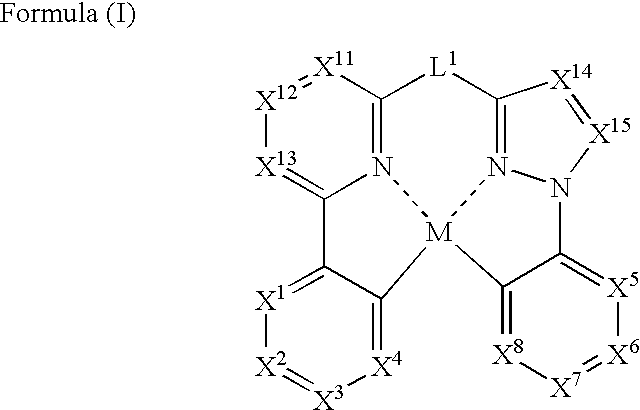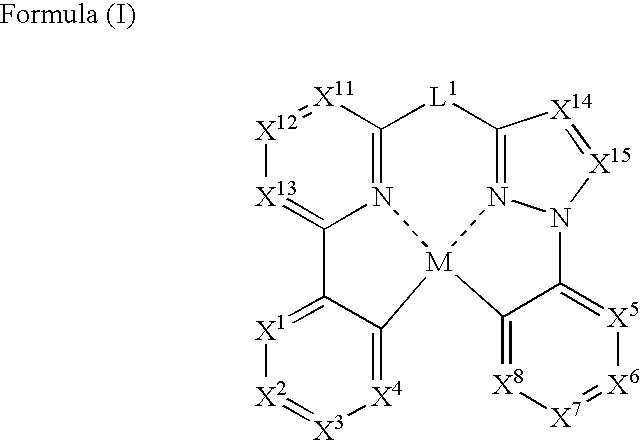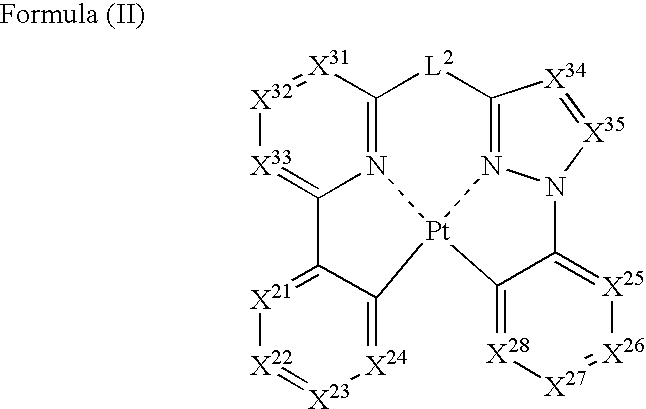Organic electroluminescence device
a technology of electroluminescence device and organic material, which is applied in the direction of luminescence screen of discharge tube, natural mineral layered products, other domestic articles, etc., can solve the problems of not being said that an organic electroluminescence device is sufficient, and devices capable of satisfying high efficiency and high durability have not been developed, etc., to achieve excellent light emission characteristics, driving voltage and durability
- Summary
- Abstract
- Description
- Claims
- Application Information
AI Technical Summary
Benefits of technology
Problems solved by technology
Method used
Image
Examples
example 1-1
[0256]An ITO film-provided glass substrate having a thickness of 0.5 mm and a size of 2.5 cm in square (manufactured by Geomatec Co., Ltd., surface resistance: 10 Ω / □) was put in a washing vessel, ultrasonically washed in 2-propanol and then subjected to a UV-ozone treatment for 30 minutes. The following organic layers (organic compound layers) were successively vapor deposited on this transparent anode (ITO film) by means of vacuum vapor deposition.
[0257]In the Examples of the invention, the vapor deposition rate is 0.2 nm / sec unless otherwise indicated. The vapor deposition rate was measured using a quartz oscillator. The film thicknesses as described below were also measured using a quartz oscillator.
[0258]The washed ITO substrate was put in a vapor deposition apparatus; copper phthalocyanine was vapor deposited thereon in a thickness of 10 nm (first layer); and HT-1 was further vapor deposited thereon in a thickness of 40 nm (second layer). H-1 and Compound (1) of the invention ...
examples 1-2 to 1-24
and Comparative Examples 1-1 and 1-2
[0259]Devices of Examples 1-2 to 1-24 and Comparative Examples 1-1 and 1-2 were prepared in the same manner as in Example 1-1, except for changing the materials used in Example 1-1 to those as shown in Table 1. Each of the organic EL devices was subjected to light emission upon application of a direct current constant voltage using a source measure unit MODEL 2400, manufactured by Toyo Corporation. As a result, a luminescent color derived from each of the used light emitting materials was obtained.
(Measurement of Driving Voltage)
[0260]Each of the organic electroluminescence devices of Examples 1-1 to 1-24 and Comparative Examples 1-1 and 1-2 was set on an emission spectrum measurement system (ELS 1500), manufactured by Shimadzu Corporation, and an applied voltage at the time when the brightness was 100 cd / m2 was measured.
(Evaluation of Driving Durability)
[0261]Each of the organic electroluminescence devices of Examples 1-1 to 1-24 and Comparative ...
example 2-1
[0266]
[0267]An organic EL device of Example 2-1 was prepared in the same manner as in Example 1-1, except that in Example 1-1, vapor deposition was carried out by changing the composition ratio of the film of the third layer (light emitting layer) from 95 / 5 (mass ratio) of H-1 to Compound (1) of the invention to 80 / 15 / 5 (mass ratio) of H-1 to A-1 to Compound (1) of the invention. The organic EL device was subjected to light emission upon application of a direct current constant voltage using a source measure unit MODEL 2400, manufactured by Toyo Corporation. As a result, bluish white light emission derived from Compound (1) of the invention was obtained.
PUM
| Property | Measurement | Unit |
|---|---|---|
| glass transition temperature | aaaaa | aaaaa |
| glass transition temperature | aaaaa | aaaaa |
| glass transition temperature | aaaaa | aaaaa |
Abstract
Description
Claims
Application Information
 Login to View More
Login to View More - R&D
- Intellectual Property
- Life Sciences
- Materials
- Tech Scout
- Unparalleled Data Quality
- Higher Quality Content
- 60% Fewer Hallucinations
Browse by: Latest US Patents, China's latest patents, Technical Efficacy Thesaurus, Application Domain, Technology Topic, Popular Technical Reports.
© 2025 PatSnap. All rights reserved.Legal|Privacy policy|Modern Slavery Act Transparency Statement|Sitemap|About US| Contact US: help@patsnap.com



